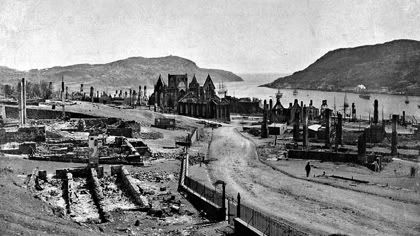
On this day in 1892 the city of St. John's, Newfoundland, was devastated by what came to be known as the
Great Fire of 1892. It all began just after 5 PM, when a pipe dropped in Timothy O'Brien's stable at Freshwater Road at the top of Carter's Hill started a conflagration that would eventually destroy most of the buildings in that city from its outskirts to its principal thoroughfare,
Water Street.
Among the thousands of homes and shops destroyed that day was the Anglican
Cathedral of St. John the Baptist, shown at the centre of the above photo, designed by
Sir Gilbert Scott; believing the churchyard's stone walls to be an effective barrier against the advancing flames, much of the city's aristocracy had sheltered themselves and their belongings in the church, only to later see them destroyed. The city's rival Roman Catholic
Basilica of St. John the Baptist survived the fire almost unscathed, mainly due to its location at the highest point of land above St. John's Harbour as well as its more durable* construction and crew of dedicated firefighters.
Despite the fact that St. John's was then (as now) principally constructed of wood, owing to its damp climate and normally cool temperatures the conditions for a fire almost never exist there; they have, however, existed occasionally in the past, and inevitably whenever they have a fire has broken out. On the fateful day in question, a rare wind from the north-west** blew sparks from the O'Brien farm out over the rooftops of the town, where it hadn't rained in a month; while work on the water mains had been completed by 3 PM earlier that day, there wasn't enough pressure in them by the time the fire got out of hand to quell the flames.
By the following morning the fire had run out of fuel, and finally went out; in total, though, less than $5,000,000 of the total estimated losses of $13,000,000 were covered by insurance, compounding the devastation for many of the 12,000 people rendered homeless by the blaze. Much of the city's relief eventually came from an international outpouring of compassion by people from Canada, Great Britain, and the United States.
*Stone and brick, rather than wood.
**The city's prevailing wind is from the East, which in this case would have blown the sparks away from populated areas.
*